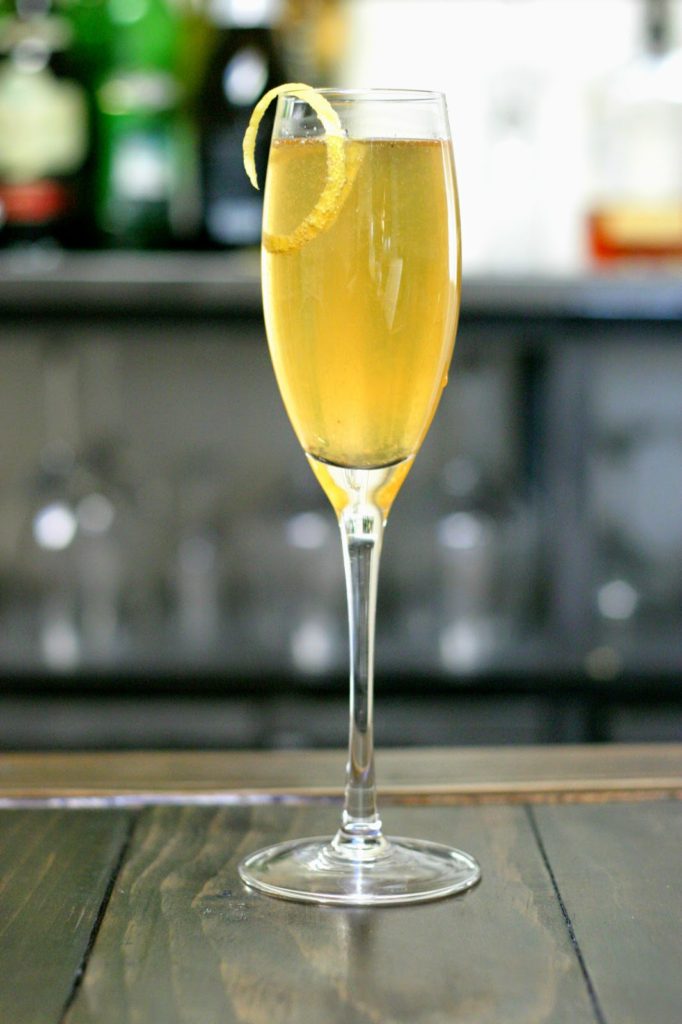If I haven’t already made it clear, I love sparkling wine cocktails. Love them. I love champagne on its own, and once you start adding spirits and mixers it only makes a good thing better. Plus, a little bit of bubbly adds an instant element of class to anything.
The French 75 is probably the most famous champagne cocktail outside of the Mimosa and maybe the Bellini, neither of which involve any hard liquor. Interestingly, there are two versions of the French 75 floating around, which can be confusing. There’s a gin version that I’ve made before, but there’s also a Cognac version. So of course I made both for this post. GarnishGuy and I agreed: we liked the Cognac better. The flavor was richer. The gin version is still very good, particularly if gin is your favorite spirit. It’s lighter and more herbal.
Whichever version you choose, be careful; this drink is named after heavy artillery. It’s got quite a kick. David Wondrich says of the French 75: “Two of these and you’d fight to defend Madonna’s honor… hell, there’s enough alcohol in it to give even Hemingway a buzz.”
Quite a claim given Hemingway’s drinking habits.
History: I’ve been trying to write this post for some time now, but the history of the French 75 is more convoluted than any I’ve encountered. It’s a popular drink, and there are two main variations and dozens of origin stories floating around. I’m still not sure I’ve got the whole story, but I hope I’ve at least got the basics down accurately.
The cocktail on which the French 75 is based was called simply a “75” and it was quite a different beast: Absinthe, Calvados, and gin. The recipe appears in the 1922 Harry’s ABC of Mixing Cocktails by Harry MacElhone of the famous Harry’s New York Bar in Paris. He writes that the recipe comes from 1915. Most folks think it was invented by – or at least popular among – WWII airmen who named it for the French 75 mm field gun.
For some reason bartenders found this particular cocktail just begging for some tweaks, and various changes were made. The first printed recipe for a “French 75” (possibly renamed to clarify its country of origin, although the gun for which it was named was also called a French 75) is in a 1927 booklet called Here’s How. It’s not an easy piece of literature to get your hands on, but this site has some of the recipes it contained, including the French 75: “Gordon water” (gin), lemon juice, powdered sugar, and champagne.
I wish that the connection between these two recipes was a bit clearer; most folks seem to accept that they’re the same cocktail at different stages of its evolution, but they are awfully different. And where did the Cognac version come from? Does it represent a separate evolutionary trajectory from that original with Calvados, or is it a variation on the gin and champagne version? The gin recipe is repeated in the Savoy Cocktail Book in 1930, but then Cognac recipes also start to pop up. In 1939, Charles Baker included a Cognac French 75 under the name “Maharaja’s Burra-Peg” in the Gentleman’s Companion Volume II: Around the World with Jigger, Beaker, and Flask. This is a variation on a Cognac and champagne cocktail called a King’s Peg, and suggests that the Cognac French 75 may have sprung from the King’s Peg and converged on a similar recipe. Or it may have a couple of different origins; in New Orleans, the French 75 is made with Cognac, and has been served there almost as long as the drink has been around.
There’s probably a lot more to this story, but I think it’s time for a drink.
French 75
2 oz. gin or Cognac (I prefer Cognac)
1/2 oz. lemon juice
1 tsp. simple syrup
Champagne
Combine gin or Cognac, lemon juice, and simple syrup in a shaker with ice and shake until chilled. Strain into a champagne flute. Top with champagne and garnish with a lemon twist.
Recipe adapted from Liquor.com.







And… as you probably know, it is the signature drink of the French 75 bar in Arnaud's restaurant (https://www.arnaudsrestaurant.com/bars/french-75/) in the French Quarter here in New Orleans. Their recipe includes Courvoisier VS, Sugar, Lemon Juice, Moet and Chandon Champagne.